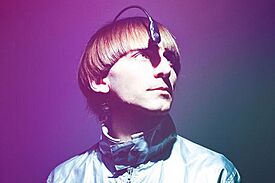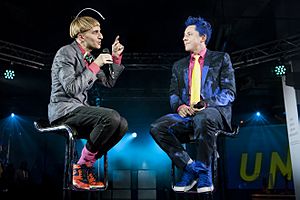Neil Harbisson facts for kids
Quick facts for kids
Neil Harbisson
|
|
|---|---|

Harbisson in 2012
|
|
| Born | 1982 (age 43–44) |
| Nationality |
|
| Education |
|
| Known for | Performance art, Body art, Cyborg art |
|
Notable work
|
|
| Awards |
|
Neil Harbisson was born in 1982. He is a British-Irish-American artist and activist who grew up in Catalonia, Spain. He is famous for being the first person in the world to have an antenna implanted in his skull.
Since 2004, many news outlets have called him the world's first legally recognized cyborg. This happened after the UK government's passport office accepted his antenna as part of his body. He is also known as the world's first cyborg artist. His antenna sends sounds through his skull. These sounds tell him about things like electromagnetic radiation, phone calls, music, videos, or images.
In 2010, he helped start the Cyborg Foundation. This group works to protect cyborg rights and support people who want to become cyborgs. In 2017, he also co-founded the Transpecies Society. This group helps people who feel they have non-human identities. It also raises awareness about challenges they face and supports the idea of self-design.
Contents
Early Life and Inspiration
Neil Harbisson's mother is Spanish, and his father is from Northern Ireland. He was born with achromat vision, which means he sees the world in black and white. He grew up in Barcelona, where he started playing piano and writing music at age 11.
When he was 16, he studied art at Institut Alexandre Satorras. He was allowed to create art without using any color. All his early artworks were in black and white.
As a teenager, Harbisson lived in a tree for several days in Mataró. He did this to stop the trees from being cut down. More than 3,000 people supported his effort. After days of protest, the city decided not to cut down the trees.
At 19, he moved to England to study music at Dartington College of Arts.
Exploring New Senses
Harbisson calls his work "cyborg art." This means he designs new senses and body parts, then merges with them. He sees his art as shaping his own mind to experience reality in new ways. He calls this "perceptionism." It's about creating new ways to see the world. He believes the artist, the art, and the audience all become one.
The Cyborg Antenna: Hearing Colors
The Cyborg Antenna helps Neil Harbisson sense colors. It is placed inside his head and grows from his skull. It has been attached to his head since 2004. This antenna lets him feel and hear colors as sounds inside his head. This includes colors humans cannot normally see, like infrared and ultraviolet.
The antenna can also connect to the internet. This allows him to receive colors from other sensors or satellites. Harbisson started creating the antenna in 2003 with Adam Montandon. Other people, like Peter Kese and Matias Lizana, later improved it. Doctors performed the antenna implant surgery even though some groups had concerns about it.
Harbisson has given five friends permission to send colors, images, videos, or sounds directly into his head. If he is sleeping, his friends can even change his dreams with colors. The first time an image was sent directly to his skull in public was on the TV show The Stream. Ruby Wax was the first person to make a phone call directly into his skull.
In 2014, Harbisson created the world's first painting using skull-transmitted colors. People in Times Square painted colored stripes onto a canvas. These colors were sent live over the internet directly to Harbisson's brain. He then correctly painted the same colored stripes onto a canvas in front of an audience nearby.
The Solar Crown: Feeling Time
The Solar Crown is a device that helps Harbisson sense time. It has a warm spot that slowly moves around his head over 24 hours. When he feels the heat in the middle of his forehead, it is midday in London. When the heat reaches his right ear, it is midday in New Orleans.
Harbisson hopes that once his brain gets used to this, he can change how he feels time. He thinks that if we can create optical illusions with our eyes, we should be able to create "time illusions" with a sense of time. If this works, he believes he could stretch or control his perception of time, age, and even time travel.
BlueTOOTH: Talking Through Teeth
The transdental communication system uses two teeth. Each tooth has a small button and a tiny vibrator with Bluetooth. When one button is pressed, it sends a vibration to the other person's tooth. One tooth was put in Harbisson's mouth, and the other in Moon Ribas's mouth.
Both Harbisson and Ribas know Morse code. This allows them to talk to each other from tooth to tooth. They first showed how this system works in São Paulo.
Art Shows and Creations
Harbisson's art has been recognized as some of the most surprising art performances ever. His work focuses on creating new senses and making art using these new senses.
His main artworks have been shown in many places. These include the 54th Venice Biennale in Italy, the Savina Museum of Contemporary Art in South Korea, and the Museumsquartier in Austria. They have also been displayed at Pioneer Works in New York and the ArtScience Museum in Singapore.
Sound and Color Art
Harbisson has created a series called "Sound Portraits." He stands in front of a person and points his antenna at different parts of their face. He writes down the different musical notes he hears. Later, he creates a sound file from these notes. He has made live portraits of many famous people, including Philip Glass, Robert De Niro, Al Pacino, and Prince Charles.
His "Colour Scores" are paintings that turn sounds, music, or voices into colors.
In 2009, Harbisson published the Human Colour Wheel. This was based on the colors he detected on hundreds of human skins from 2004 to 2009. His study showed that humans are not truly black or white. Instead, they are different shades of orange, from very dark to very light.
He has also shown "Capital Colours." These artworks display the main colors of different cities he has visited. He scans the colors of each city until he can show it with at least two main hues.
Media and Public Awareness
Harbisson has helped many people learn about cyborgs, artificial senses, and human evolution. He often gives talks at universities and conferences. He has been part of science, music, fashion, and art festivals. These include the British Science Festival and TEDGlobal. He has also been a popular topic on Twitter many times.
In 2013, a short film about Neil Harbisson won a big award at the Sundance Film Festival. In 2015, a black and white film called Hearing Colors about Harbisson in New York won an award at the Tribeca Film Festival.
He has appeared in documentaries on Discovery Channel and other TV shows. He has also been on radio shows and featured in newspapers and magazines like The New York Times and Wired.
Speaking Out for Cyborgs

In 2004, Neil Harbisson's British passport renewal was first turned down. The UK Passport Office did not want him to have an electronic device on his head in his passport photo. Harbisson wrote back, explaining that he identifies as a cyborg. He said his antenna should be seen as a body part, not just a device. After several weeks, his photo was accepted.
In 2011, during a protest in Barcelona, police damaged Harbisson's antenna. They thought they were being filmed. Harbisson filed a complaint, saying it was physical aggression, not just damage to property. He considers the antenna to be part of his body.
Working with Others
Harbisson has worked a lot with his childhood friend and cyborg artist Moon Ribas. They have done many performances and art projects together. His first performances as a cyborg were at Dartington College of Arts, where he used pianos and worked with other students. He has also performed with artist Pau Riba. They share an interest in cyborgs and have performed together in Barcelona and other places. One of their projects is called Avigram.
Images for kids
-
Neil Harbisson conducting a color concert at Palau de la Musica Catalana, Barcelona (2014)
-
Sonochromatic Records exhibited at Pioneer Works, New York (2014)
See also
 In Spanish: Neil Harbisson para niños
In Spanish: Neil Harbisson para niños
- Andy Warhol
- Moon Ribas
- Cyborg Foundation



